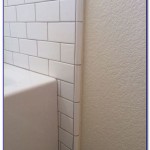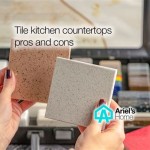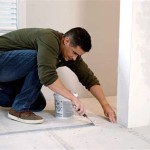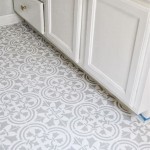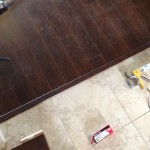Do I Need Backer Board For Bathroom Floor Tile?
When undertaking a bathroom renovation project that includes tile flooring, a critical consideration is the necessity of backer board. Backer board, also known as cement board or tile backer, serves as a substrate upon which tiles are installed. Its primary function is to provide a stable, durable, and water-resistant surface, ensuring the longevity and integrity of the tiled floor. Determining whether backer board is required involves assessing several factors, including the existing subfloor material, the intended tile type, and the anticipated moisture exposure in the bathroom environment.
The purpose of this article is to provide a comprehensive overview of backer board and its role in bathroom floor tile installation. It will delve into the reasons why backer board is often recommended, the types of backer board available, and the factors that influence the decision of whether or not it is necessary for a specific project. Understanding these aspects will empower homeowners and contractors to make informed choices, ensuring a successful and long-lasting tile installation.
Understanding the Role of a Subfloor
A subfloor serves as the foundational layer beneath the finished flooring material. In bathroom settings, the subfloor typically consists of plywood or oriented strand board (OSB). While these materials provide structural support, they are susceptible to moisture damage, expansion, and contraction when exposed to humidity and water. These properties make them unsuitable as a direct substrate for tile, which is a rigid material that does not accommodate movement well. Consequently, installing tile directly onto a plywood or OSB subfloor can lead to cracking, loosening, and eventual failure of the tiled surface.
Backer board bridges the gap between the subfloor and the tile, providing a stable and water-resistant surface that minimizes the risks associated with direct tile installation on wood-based materials. It acts as a decoupling membrane, reducing the transfer of stress from the subfloor to the tile layer. This decoupling effect is especially crucial in bathrooms, where temperature fluctuations and moisture levels are consistently high, making the subfloor prone to expansion and contraction. The installation of backer board mitigates these effects, safeguarding the integrity of the tile floor.
Furthermore, backer board offers improved tile adhesion due to its textured surface, which provides a stronger bond for thin-set mortar, the adhesive used to secure tiles. This enhanced adhesion helps to prevent tiles from shifting or becoming dislodged over time, ensuring a durable and aesthetically pleasing finish. Backer board also provides a consistent and level surface, essential for achieving a professional-looking tile installation.
Key Benefits of Using Backer Board for Bathroom Floor Tile
The advantages of using backer board in bathroom tile projects extend beyond simply providing a stable surface. Its properties contribute significantly to the overall performance and longevity of the tiled floor.
Water Resistance: Backer board is manufactured to be highly resistant to water damage. Unlike plywood or OSB, it does not readily absorb moisture, preventing warping, rotting, or mold growth. This is particularly important in bathrooms, where spills, splashes, and high humidity are common. The water-resistant nature of backer board helps maintain the structural integrity of the floor and prevents potential health hazards associated with mold and mildew. Some backer boards contain additives that further enhance their water resistance, making them suitable for use in wet areas such as shower floors.
Stability and Rigidity: Backer board provides a stable and rigid substrate for tile, minimizing the risk of cracking or movement. Its dimensional stability ensures that the tiled surface remains flat and level over time, even under heavy foot traffic. The rigidity of the backer board also helps to distribute weight evenly, preventing localized stress on individual tiles. This is crucial for maintaining the aesthetic appeal and structural integrity of the tiled floor.
Enhanced Tile Adhesion: The surface of backer board is designed to promote strong adhesion with thin-set mortar. Its textured surface provides a mechanical bond that helps to prevent tiles from slipping or becoming dislodged. This enhanced adhesion contributes to the longevity of the tiled floor, reducing the need for repairs or replacements. Specific types of backer boards even have specially engineered surfaces to maximize the adhesive bond.
Beyond these core benefits, backer board also offers improved fire resistance compared to wood-based subfloors. It can help to slow the spread of fire and provide valuable time for evacuation in the event of a fire emergency. While not a primary consideration for most bathroom renovations, this added safety feature is a significant advantage.
Types of Backer Board Available
Several types of backer board are available for bathroom tile installation, each with its own unique properties and applications. The choice of backer board often depends on the specific requirements of the project, including the tile type, subfloor condition, and budget.
Cement Board: Cement board is the most common type of backer board used for tile installation. It is composed of cement, reinforced with fiberglass mesh. Cement board is highly durable, water-resistant, and resistant to mold and mildew. It is suitable for both floors and walls, and can be used in wet areas such as showers and tub surrounds. Cement board can be cut to size using a utility knife or a saw, and is typically screwed or nailed to the subfloor.
Fiber Cement Board: Fiber cement board is similar to cement board, but it contains cellulose fibers for added strength and flexibility. The addition of fiber makes it more resistant to cracking and warping. Fiber cement board is also slightly lighter than cement board, making it easier to handle and install. It is a good choice for projects where weight is a concern, such as installing tile on upper floors.
Glass Mat Backer Board: Glass mat backer board is composed of a gypsum core, faced with a fiberglass mat. This type of backer board is highly water-resistant and mold-resistant, making it suitable for wet areas. Glass mat backer board is also lightweight and easy to cut, making it a popular choice for DIY projects. However, it is generally not as strong or durable as cement board or fiber cement board, so it may not be suitable for high-traffic areas or where heavy tiles are being installed.
Coated Foam Backer Board: These newer types of backer board consist of a foam core coated with a waterproof layer. They are lightweight, easy to cut, and offer excellent insulation properties. Some varieties also incorporate features like pre-printed grid lines to aid in tile layout. While generally more expensive than traditional options, their ease of use and high performance can make them attractive for certain applications. However, it is important to choose a product specifically designed for floor applications as some foam backer boards are intended for walls only.
When selecting a backer board, consider the manufacturer's recommendations, the specific environmental conditions of the bathroom, and the type of tile being installed. Consulting with a professional tile installer can also provide valuable guidance in choosing the best backer board for your project.
When Is Backer Board Truly Necessary?
While backer board is generally recommended for bathroom floor tile installations, there are certain situations where it may be considered optional or where alternative solutions might be viable. Understanding these scenarios is crucial for making informed decisions and optimizing the project budget.
Existing Concrete Subfloor: If the bathroom floor already consists of a solid concrete slab, backer board may not be strictly necessary. Concrete provides a stable and rigid surface for tile installation. However, it is still important to ensure that the concrete surface is clean, level, and free of cracks or imperfections. If the concrete is uneven or damaged, a self-leveling compound can be used to create a smooth and even surface before tiling. Additionally, it is vital to check for moisture transmission through the concrete slab, particularly in below-grade bathrooms. If moisture is present, a waterproofing membrane should be applied before installing the tile, even if backer board is not used.
Use of Uncoupling Membranes: Uncoupling membranes are designed to isolate the tile layer from the subfloor, preventing cracks from transferring to the tile. These membranes can be used in lieu of backer board in some situations, particularly when the subfloor has minor imperfections or when there is concern about movement. However, uncoupling membranes may not provide the same level of water resistance as backer board, so they may not be suitable for wet areas such as showers. Furthermore, uncoupling membranes often require a very flat substrate in order to function properly.
Small-Format Tiles: When using small-format tiles (e.g., mosaic tiles), the collective grout lines provide a degree of flexibility that can accommodate some subfloor movement. In such cases, if the subfloor is relatively stable and level, and if moisture exposure is minimal, backer board may not be absolutely essential. However, it is still generally recommended to use backer board to provide a more reliable and long-lasting installation. The benefits of increased water resistance and improved adhesion typically outweigh the added cost and effort of installing backer board.
Subfloor Deflection: Before making a final decision, it's critical to assess the subfloor for deflection, or how much it bends under weight. Bathroom floors should be strong enough to resist excessive bending, which can lead to cracked tiles and grout. Building codes specify minimum requirements for subfloor stiffness, often expressed as a deflection rating (e.g., L/360 or L/720, where L is the span). If the existing subfloor doesn't meet these requirements, backer board alone may not be sufficient. Reinforcing the subfloor with additional layers of plywood or bracing may be necessary before installing any tile flooring.
Ultimately, the decision of whether or not to use backer board depends on a comprehensive assessment of the specific project conditions. When in doubt, it is always best to err on the side of caution and install backer board to ensure a durable and long-lasting tile installation.

How To Install Cement Board On A Floor Diy Family Handyman

Installing Cement Board In The Bathroom Angie S Roost

6mm No More Ply Tile Backer Board

Tiling On Wooden Floors Part 4 Overboarding Bathroom Guru

How To Install Cement Backer Board For Floor Tile Installation The Home Depot

Tile Backerboard Material Options Fine Homebuilding

What Lies Beneath Tsj

Cement Board Installation On Floors 5 Mistakes To Avoid Diytileguy

How To Install Cement Board In 3 Easy Ways Q3 2024 Infographic

Tiling On Wooden Floors Part 4 Overboarding Bathroom Guru
Related Posts



